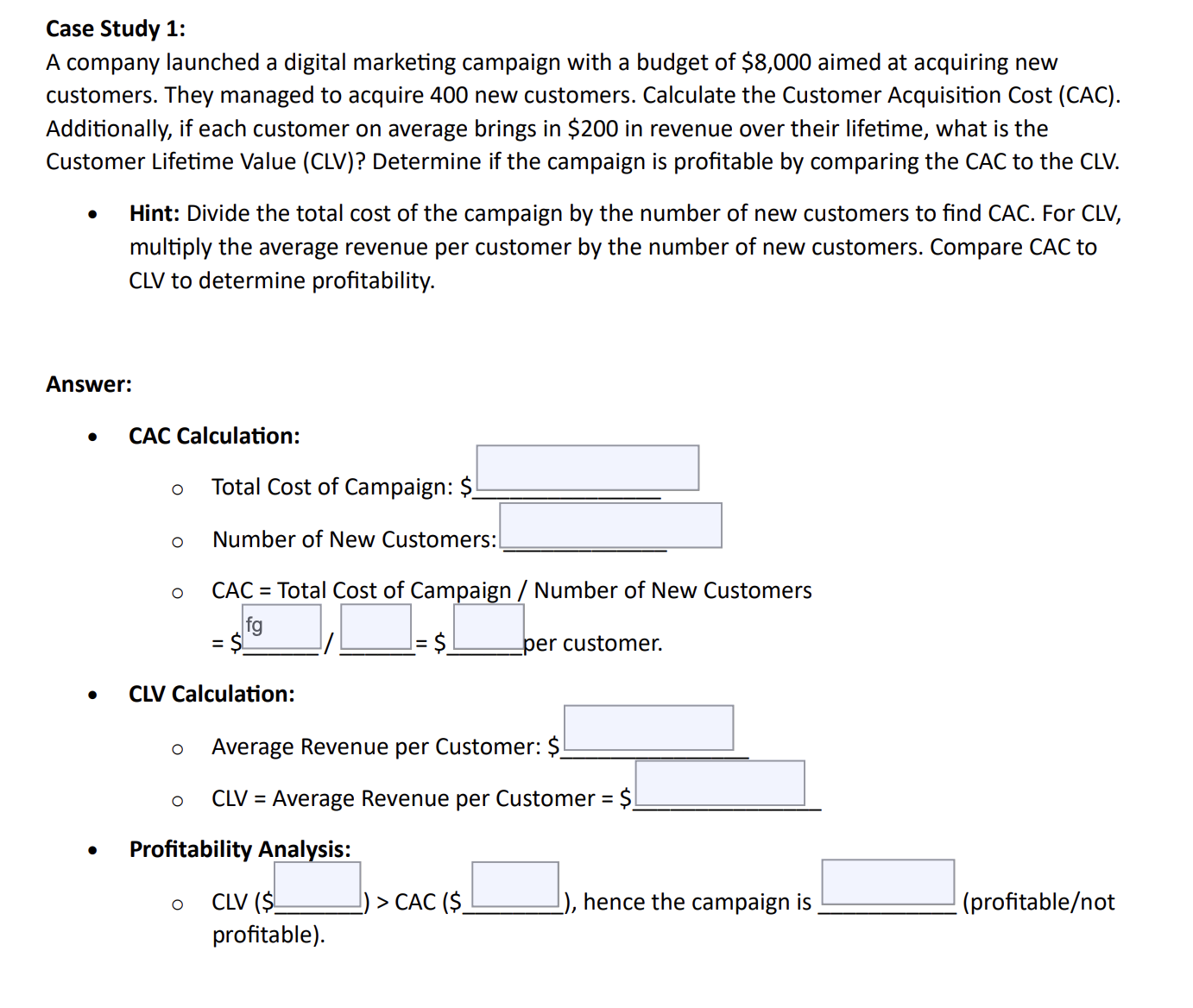Answered step by step
Verified Expert Solution
Question
1 Approved Answer
Case Study 1 : A company launched a digital marketing campaign with a budget of ( $ 8 , 0 0 0
Case Study :
A company launched a digital marketing campaign with a budget of $ aimed at acquiring new customers. They managed to acquire new customers. Calculate the Customer Acquisition Cost CAC Additionally, if each customer on average brings in $ in revenue over their lifetime, what is the Customer Lifetime Value CLV Determine if the campaign is profitable by comparing the CAC to the CLV
Hint: Divide the total cost of the campaign by the number of new customers to find CAC. For CLV multiply the average revenue per customer by the number of new customers. Compare CAC to CLV to determine profitability.
Answer:
CAC Calculation:
Total Cost of Campaign: $
Number of New Customers:
quad CAC Total Cost of Campaign Number of New Customers
: $ jer customer.
CLV Calculation:
Average Revenue per Customer: $
CLV Average Revenue per Customer $
Profitability Analysis:
CLV $ CAC $ hence the campaign is profitablenot profitable Case Study :
A digital marketing manager is assessing a recent campaign that generated $ in revenue from $ spent on advertisements. What is the Return on Ad Spend ROAS If the target ROAS is did the campaign meet the target?
Hint: Divide the total revenue generated by the cost of advertisements to find ROAS. Compare the calculated ROAS to the target ROAS.
Answer:
ROAS Calculation:
Revenue Generated: $
Cost of Advertisements: $
ROAS Revenue Cost of Ads
$ $
Target Comparison:
Actual ROAS Target ROAS hence the campaign the target. met or not met Case Study :
An online retailer tracked their ad performance and found that out of impressions, they received clicks. Calculate the ClickThrough Rate CTR Additionally, if of those who clicked made a purchase, what is the Conversion Rate?
Hint: Divide the number of clicks by the number of impressions and multiply by to find CTR To find the conversion rate, calculate the percentage of clicks that resulted in purchases.
Answer:
CTR Calculation:
Number of Impressions:
Number of Clicks:
quad CTR Number of Clicks Number of Impressions
Conversion Rate Calculation:
Number of Conversions of
Conversion Rate Number of Conversions Number of Clicks Case Study :
A company's marketing efforts generated website visitors. Out of these visitors, added products to their cart, and completed the purchase. Calculate the AddtoCart Rate and the Conversion Rate from visitors to customers.
Hint: Divide the number of addtocart actions by the number of website visitors and multiply by to find the addtocart rate. To find the conversion rate, divide the number of purchases by the number of visitors and multiply by
Answer:
AddtoCart Rate Calculation:
Number of Website Visitors:
Number of AddtoCart Actions:
AddtoCart Rate Number of AddtoCart Actions Number of Website Visitors quad
Conversion Rate Calculation:
Number of Purchases:
Conversion Rate Number of Purchases Number of Website Visitors Case Study :
A company reduced its average Customer Acquisition Cost CAC from $ to $ by optimizing their ad targeting. If they acquired new customers, calculate the total savings. Additionally, if each customer has a Customer Lifetime Value CLV of $ how much profit did the company make from these new customers?
Hint: Subtract the reduced CAC from the initial CAC and multiply by the number of new customers to find total savings. To find profit, subtract the reduced CAC from CLV and multiply by the number of new customers.
Answer:
Total Savings Calculation:
Initial CAC: $
Reduced CAC: $
Savings per Customer Initial CAC Reduced CAC
$ $ $
Total Savings Savings per Customer Number of New Customers
$ $
Profit Calculation:
CLV per Customer: $
Profit per Customer CLV Reduced CAC
$ $ $
Total Profit Profit per Customer Number of New Customers
$ $

Step by Step Solution
There are 3 Steps involved in it
Step: 1

Get Instant Access to Expert-Tailored Solutions
See step-by-step solutions with expert insights and AI powered tools for academic success
Step: 2

Step: 3

Ace Your Homework with AI
Get the answers you need in no time with our AI-driven, step-by-step assistance
Get Started


